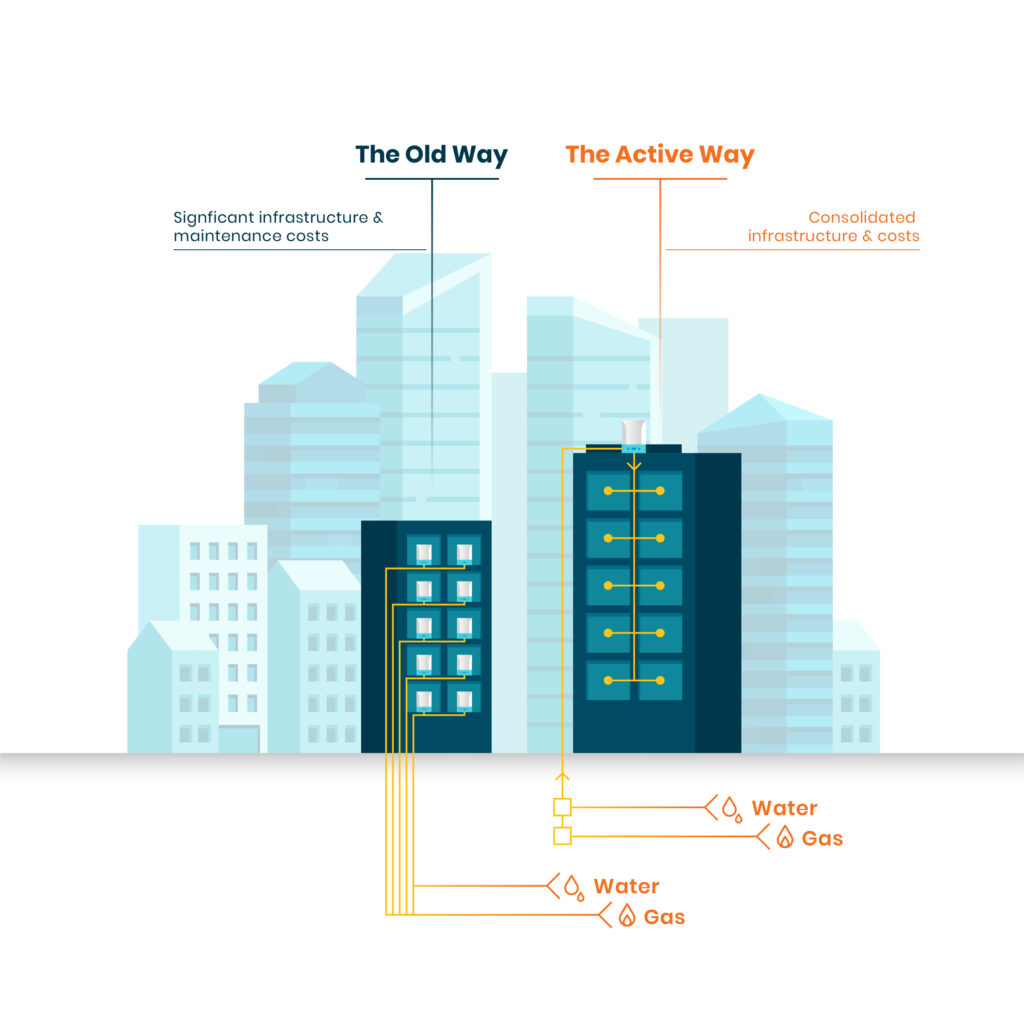Demystifying Local Utility Networks

Local Utility Networks, also known as embedded networks and bulk/centralised hot water networks, should be a fantastic asset for Owners Corporations (OC’s). They have the potential to earn an ongoing revenue stream for OC’s, allowing them to offset Lot Owners’ costs and to reduce tenant rates. They also allow the installation of solar arrays to offset total building electricity usage, creating infrastructure that facilitates sustainable services such as EV charging and electric hot water.
How does it work?
With a Local Energy Network, instead of each home being individually connected to the grid, there is one Parent Meter that connects the building to the grid. Electricity is then distributed from the Parent Meter, through the electrical infrastructure in the building, to privately owned meters. The meters record electricity usage, allowing a Local Utility Network Operator, such as Active working on behalf of the OC, to bill tenants for their usage.

Local Water Networks operate in a similar way to electricity. Hot water is considered centralised if there is one main hot water plant that supplies all individual tenancies with hot water. The hot water plant could be gas or electric. The energy used by the plant is supplied by a main gas meter or the Parent Meter.
You might be asking – how does a Local Utility Network benefit my OC

It’s all about the way Local Utility Network generates revenue.
Instead of each tenancy buying their power individually, a Local Utility Network Operator purchases power in bulk for the entire building, allowing the OC to access competitive wholesale rates.
Power is then on-sold to residents at retail rates, which are higher than wholesale rates, generating revenue for the OC. This revenue is either paid to the OC as an ongoing return which can be used to offset OC costs and/or common area costs, allocated to tenants in the form of reduced rates, or a combination of both!
There are a few financial models Operators use to manage a Local Utility Network. The main ones are:
- A fully managed service where the Operator fixes their operational fees. Operations are transparent, and the OC is able to see exactly how much revenue the Local Utility Network generates, what the wholesale costs are, and how much the Operator is charging for their services. This model is the Gold Standard, with the OC remaining in control of important decisions such as signing off on any rate changes.
- A guaranteed rebate model is where, instead of fixing their fees, the Operator recovers operational costs from the revenue generated by the Local Utility Network and sets a guaranteed rebate and/or tenant discount for the term of the contract.
- A retail model is where the Operator withholds all revenue and pays nothing to the OC.
- A billing only model, usually used in commercial buildings e.g. shopping centres, where the Operator is not involved with tenants and simply reads the meters and sends copies of invoices to building management for distribution.
It’s important to note that different Operators may have different names for their models. Ask Operators which model they are offering, and ensure promises made in a proposal are reflected in any associated contracts.
Next steps
Managed service models, in which a Local Utility Network Operator fixes their fees and provide operational transparency, haven’t always been the status quo. Originally, many Local Utility Networks were managed by Operators using models where the OC does not receive any, or much of a benefit.
An OC manager or member can determine the conditions of their Local Utility Network service by requesting a copy of their Local Utility Network contract (embedded network and/ or bulk hot water contract) from their incumbent Operator. The contract should advise whether there are any fixed fees, guaranteed rebates/discounts and/or special conditions.
If the OC is not receiving benefits, the OC manager or member should check whether their contract is ongoing or whether it can be terminated. If it can be terminated, they should speak to a trusted Local Utility Network Operator to determine what kinds of benefits the building could realistically generate for the OC and residents. There should be no costs to generate a high-level proposal.
Local Utility Networks have been made out to be a lot more complicated than they are. With information there is power, and your understanding of Local Utility Networks can empower the buildings you manage. Local Utility Networks for electricity and water are often an untapped asset and the more understanding and involvement the OC has in managing their network, the more they are set up to benefit from their asset.
All it takes is to get in touch with a trusted Local Utility Network Operator to discuss the situation and find the solution. If you would like to explore this further, please contact us at sales@activeutilities.com.au and we will help turn your network into the asset it should be.
View Comments
(0)